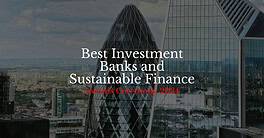Despite some political challenges, ESG is becoming a higher priority for forward-thinking corporate treasury teams.

US politics are driving a vocal backlash against corporate efforts to address environmental, social, and governance issues. In March, 19 US state governors called for limiting the discretionary power of of state pension fund managers, warning that “the proliferation of ESG throughout America is a direct threat to the American economy, individual economic freedom and our way of life.” Five months later, a survey by the Conference Board found that 61% of US companies expect the backlash to “persist or intensify” over the next two years.
And yet politics only goes so far. This summer, extreme events around the globe—wildfires on the one hand and floods on the other—offered highly visible examples of how climate change will impacts business. On the buy side, both retail and corporate consumers are demanding greater attention to sustainability and resilience. Despite the backlash, the Conference Board survey concluded firmly: “Most firms do not plan to retreat from their ESG commitments.”
High-emitting industries still face the biggest public pressure to transition to a low-carbon economy, but the transition requires action along the value chain in all sectors. A continent away from those US governors, Peru’s agricultural businesses engage with the environment on every level, seeking low-carbon solutions at every step. “Agribusiness is one of the most important pillars of the economy in Peru and is also a showcase for good practice in Latin America as a whole,” says Nekane Martínez, head of sustainability at BBVA in Peru. “The fact that the sector has significant international visibility, with export demand from the US and Europe, has prompted our agro-industrial companies to seek certification and to prioritize sustainability in their models.”
Competing Objectives
The first challenge for corporate treasurers looking to determine and achieve ESG-related goals is to define and prioritize them, says Tomohiko Shinohara, research fellow at FinCity Tokyo, a non-governmental organization that promotes the city as a financial center.
“China is a significant provider of lithium batteries and solar panels, and purchasing solar panels,” he notes, citing research from the US Center for Strategic and International Studies. “China may be touted from the ‘E’ point of view but at the same time may be criticized for human rights reasons, under the ‘S.’”
Financed emissions are another contentious area, FinCity Tokyo has learned from its member firms. “These pose a dilemma whereby the more a bank does to help company transitions, the more greenhouse gas emissions they will be held responsible for as a result,” he says. “This is also the case for green bonds and loans; the lower interest rates of these loans are clearly a merit for companies, but in return, they may not provide sufficient spread for financial institutions. Designing incentives may be a challenge.”
In Europe, the latest annual Corporate Debt and Treasury Report from Herbert Smith Freehills and the Association of Corporate Treasurers was bearish on the viability of sustainable finance, including “questions as to whether sustainable finance really moves the needle on a corporate’s ESG journey, making it a worthwhile pursuit.”
Calculating the Payoff
Treasurers are working to quantify the impact of ESG efforts, using disclosure as a principal tool for engaging successfully with investors. Shinohara says awareness of sustainable benchmarks in these disclosures is growing fast in Japan. All 1,834 companies on the Tokyo Stock Exchange (TSE) prime market as of mid-August are mandated to complete a task-force designed disclosure of climate-related financial issues.
Japanese companies are also seeing some evidence of ESG’s bottom-line benefits. According to Hitachi, ESG activities improved return on invested capital by roughly 1%. By quantifying the positive impact of such efforts as relate to corporate values, companies are confronting skepticism around ESG and starting to show how important a component ESG activities are to their business strategy.”
Despite some grumbling, attitudes regarding ESG have changed considerably in recent years as corporates take a longer view to understanding their future. Regulation has been among the greatest drivers of change, especially in Europe, which is taking the lead globally in this arena.
In May, the final text of the EU’s Green Bond Standard was leaked shortly ahead of its official adoption. While voluntary, GBS compliance is expected to become a highly sought-after seal for issuers in the EU.
In June, the European Commission proposed a series of new measures designed to improve and strengthen its sustainable finance framework, incorporating further activities into the EU taxonomy for sustainable activities, and put forward new rules for ESG rating providers to increase transparency for sustainable investments. June also saw the EU Parliament approve the Corporate Sustainability Due Diligence Directive, designed to ensure that large companies operating in the EU or with undertakings there address adverse human rights or environmental impacts of their actions, and do the same through their value chains.
Barely pausing for breath, the final standards under the EU’s Corporate Sustainability Reporting Directive, designed to evaluate large companies’ non-financial performance, were announced at the end of July. For treasurers, these new standards will provide a firmer foundation to build on going forward.
The new round of EU rules is likely to influence decision-making further afield, says BBVA’s Martínez, since corporate investors are showing a growing interest in ESG criteria in their portfolios. She says the agenda has shifted, as what was once ‘nice to have’ becomes as ‘standard.’
“Those actions that companies until now considered voluntary, will no longer be [voluntary],” she says. “New directives will make mandatory some actions that are now part of corporate social responsibility strategies.” In Peru, she notes, the Ministry of Environment (MINAM), in consultation with the most relevant players, including BBVA, is now working on an Environmental Finance Classification System as well as a National Green Finance Taxonomy that will add much-desired clarity for corporate treasurers and their bankers.
Sustainability has a growing presence in banks’ stated objectives as well. At BBVA, it is fundamental to the bank’s stated goal to “bring the age of opportunity to everyone.” Amongst its strategic priorities are to help clients turn transition risks into opportunities.
“BBVA is neutral in its own emissions in the main geographies in which it operates and has assumed the Net Zero 2050 commitment, not only for its own emissions but also for emissions financed by our clients,” Martínez says. “This means that many of our clients are going to develop and implement investment-intensive transition plans, and our role here is clear: supporting them with advice and financing, facilitating a transition that is as fair and inclusive as possible: creating opportunities and leaving no one behind.”
A Wider Embrace
The green transition is not to the only area of focus across the ESG spectrum, where cultural changes are shifting up a gear in tandem. In Japan, Shinohara observes, gender issues and green policies are two areas of focus for Fumio Kishida’s, “with the green component represented in his GX [Green Transformation] Strategy and the social element in the goal of 30% female representation on boards”: a standard that foreign institutional investors have long been pushing for.
Canon’s CEO Fujio Mitarai was nearly voted out at the manufacturer’s annual general meeting earlier this year, Shinohara notes, reportedly because foreign institutional investors were concerned about the absence of female board members.
Japan’s Ministry of Economy, Technology, and Industry, meanwhile, has developed a Sustainability Transformation initiative to honor companies for efforts to improve long-term sustainable corporate value by “synchronizing the sustainability of society with that of companies.” Thus, dialogue among regulators, citizens and corporate finance leaders is gaining momentum.
Can the combination of sustainable finance, government regulatory action, and corporate competitiveness efforts really “move the needle” on the ESG journey? Despite treasurers’ concerns, a recognition appears to be growing that companies that invest in ESG initiatives have a clearer long-term strategy and purpose: itself a competitive advantage.



